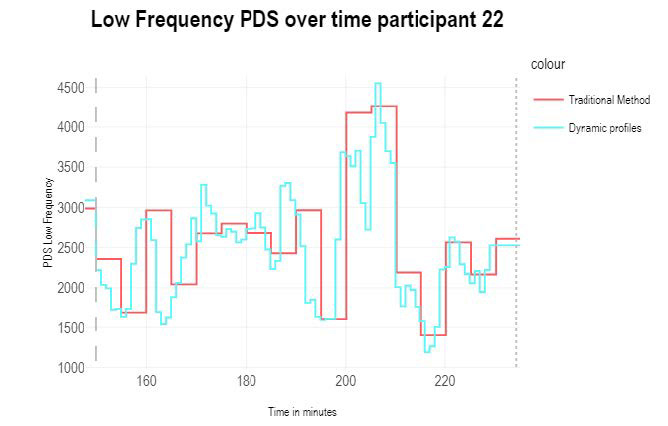About this project
This project consisted of cleaning Heart Rate Variability (HRV) data and analysis through a dynamic profiling method. The HRV data was gathered by Iris Reijmerink, a PhD student at the University Medical Center Groningen (UMCG).
Roles: Researcher, data analist
Skills: Data analysis, artifact removal, data preparation, (descriptive) statistics
Tools: R studio, PreCAR, CARSPAN
Problem
The aim of the project was two-fold: to help Iris clean up and parse her dataset and to research the possibility of a different method of analysis of HRV data.
Solution
The collected data needed a lot of artifact removal. Since this is a very time-consuming and complex task, all artifacts from the dataset were removed with two other students.
On top of this, I performed an analysis of HRV using dynamic windows, instead of a traditional, 5-minute method.
About the data
The data was gathered at the UMCG. 10 Surgeons and 10 resident-surgeons from different surgical specialties, participated in the research. HRV data was gathered during a mentally demanding operating-day, includeing intraoperatively (during surgery) and during a non-operative day (as a control measure).
Iris performed an HRV analysis of her own on a portion of the dataset also, using the 'traditional' five-minute window method. Her analysis was therefore a suitable analysis to compare my dynamic-window analysis to.
Heart rate variability is the measure of variation of amount of time between heartbeats.
Artifact removal
The artifact removal and data parsing was performed using PreCAR software, which automatically detects heartbeats and therefore can create the Interbeat Intervals that the determine the HRV. However, the software often incorrectly picks up on heartbeats or misses them, so manual adjustment was done by me and two other students. Also potential arrythmia artifacts are removed from the data to ensure reliable outcomes.
Data analysis
Analysis using the Frequency Domain can result in more detailed information on those changes than using Time Domain analysis methods. Therefore, the methods of Power Spectrum in Low Frequency (SPLF), Power Spectrum in Mid Frequency (SPMF) and Power Spectrum in High Frequency (SPHF) were used to visualize the Power Density Spectra (PDS) over time. Also the ratio between the SPLF and SPHF is visualized, together with the LF/HF ratio.
To obtain the PDS of the Low Frequency (0.04-0.15 Hz), the Mid Frequency (0.07-0.15 Hz) and the High Frequency (0.15-0.4 Hz), the data that have been prepared is analysed using CARSPAN software. The profiles were created by setting the window-length to 300 seconds (five minutes, which is the conventional interval for HRV analysis) and the time-increment to 60 seconds (resulting in the 1-minute overlap between blocks).
The hypothesis was that by using dynamic windows with a shift of 1 minute instead of 5 minute intervals, more insight would be gained in the transient changes of HRV (short-term stress for example). Compared to regular, non-dynamic, 1-minute intervals, it might be the case that there is not enough data over that one minute to produce significant outcomes. Therefore using a 'sliding window' of 5 minutes with a 1-minute increment could be a good solution for seeing more transient HRV changes. In live HRV data analysis, it is easier to see sudden rises or decreases in HRV this way, which can be an indicator of stress.

Traditional 5 minute windows (pink) vs. dynamic windows (blue)
Results
From this exploratory research into dynamic profiles of HRV data in surgeons and surgical residents, it can be concluded that all four different time courses of the HRV analysis (SPLF, SPMF, SPHF and LF/HF) show similar results on delineating the dynamics of transient HRV changes. In every time course, issues concerning missing peaks and valleys and potential earlier detection of upward or downward trends can be observed, when comparing the traditional method to the dynamic method of analysis. Because the interplay between all four frequencies gives a lot of information about the mental workload and fatigue of an individual, the insights of this exploratory research could potentially contribute to the understanding of stress and fatigue in surgeons and surgical residents over short courses of time.
